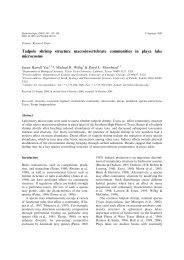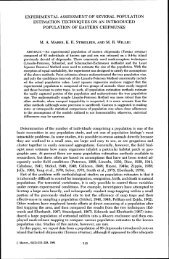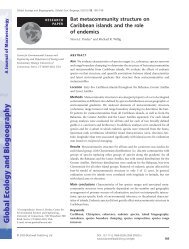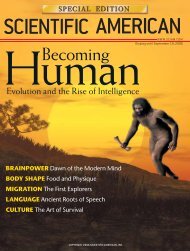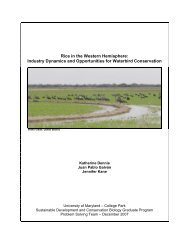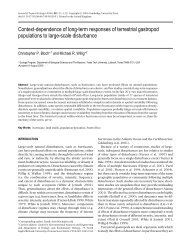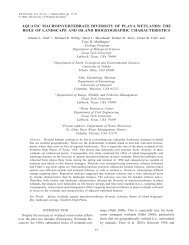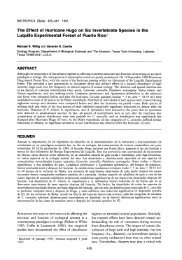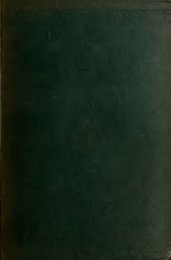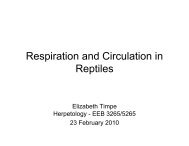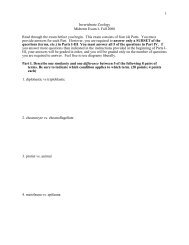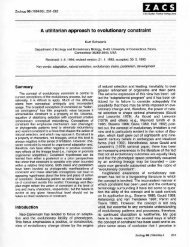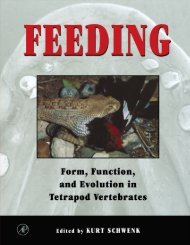Comparative biology and the importance of cladistic classification: a ...
Comparative biology and the importance of cladistic classification: a ...
Comparative biology and the importance of cladistic classification: a ...
You also want an ePaper? Increase the reach of your titles
YUMPU automatically turns print PDFs into web optimized ePapers that Google loves.
76 K. SCHWENK<br />
chamber owing to space limitation in <strong>the</strong> head, erroneously believing that an<br />
increase in visual ability must be linked to an increase in eye size. He <strong>the</strong>n went<br />
on to discuss <strong>the</strong> relationship between habitat <strong>and</strong> vomeronasal development<br />
(p. 184):<br />
Jacobson’s organ is a specialized part <strong>of</strong> <strong>the</strong> olfactory apparatus associated with a<br />
ground living-existence. . . . The degree <strong>of</strong> specialization varies within <strong>the</strong> lizards <strong>and</strong><br />
can be classified according to <strong>the</strong> functioning mechanisms.. . . In arboreal forms <strong>the</strong><br />
organ loses its <strong>importance</strong> in <strong>the</strong> life <strong>of</strong> <strong>the</strong> lizards, <strong>and</strong> as a consequence becomes very<br />
reduced-as in some agamids, non-sensory-as in Anolis, or completely absent-as in<br />
chameleons. . . . Scansorial lizards have a Jacobson’s organ whose development is<br />
intermediate between <strong>the</strong> conditions in terrestrial <strong>and</strong> arboreal lizards.<br />
Thus we see in Pratt (1948) <strong>the</strong> establishment <strong>of</strong> two generalizations: (1) <strong>the</strong>re is<br />
a trade-<strong>of</strong>f between vision <strong>and</strong> chemoreceptions; <strong>and</strong> (2) arboreality is associated<br />
with an increase in vision <strong>and</strong> <strong>the</strong>refore, a decrease in chemoreception, whereas<br />
terrestriality is associated with a reliance <strong>of</strong> chemoreception.<br />
Given first Camp’s ( 1923) dichotomous <strong>classification</strong> (Ascalabota vs.<br />
Autarchoglossa) , second, his generalization <strong>of</strong> this to include arboreality vs.<br />
terrestriality (arboreal Ascalabota vs. terrestrial/fossorial Au tarchoglossa) , <strong>and</strong><br />
third, Pratt’s ( 1948) association <strong>of</strong> habitat with sensory modality (visual arboreal<br />
species vs. chemosensory terrestrial/fossorial species), it was perhaps inevitable<br />
that <strong>classification</strong> <strong>and</strong> sensory modality would ultimately be linked (visual<br />
Ascalabota vs. chemosensory Autarchoglossa) . I find this syllogism first<br />
expressed in Underwood ( 195 1 : 184) :<br />
Camp divides <strong>the</strong> lizards into two groups: <strong>the</strong> Ascalabota <strong>and</strong> Autarchoglossa. He<br />
points out that <strong>the</strong> Ascalabota show a strong tendency towards an arboreal habit <strong>and</strong><br />
no tendency towards reduction <strong>of</strong> <strong>the</strong> limbs. On <strong>the</strong> o<strong>the</strong>r h<strong>and</strong>, <strong>the</strong> Autarchoglossa<br />
show relatively slight arboreal tendencies, but a pronounced tendency towards<br />
reduction <strong>of</strong> <strong>the</strong> limbs.. . . It may be pointed out that <strong>the</strong> Ascalabota are sight feeders<br />
<strong>and</strong> as such seem to be relatively little dependent on Jacobson’s organ in <strong>the</strong> finding <strong>of</strong><br />
food.. . . On <strong>the</strong> o<strong>the</strong>r h<strong>and</strong>, <strong>the</strong> Autarchoglossa show a strong tendency for smell to<br />
supersede sight as <strong>the</strong> important sense in food-finding, with corresponding elaboration<br />
<strong>of</strong> Jacobson’s organ. Speaking generally, autarchoglossids which tend towards<br />
secretive habits rely more than ever on <strong>the</strong> sense <strong>of</strong> smell, with consequent fur<strong>the</strong>r<br />
reduction in <strong>the</strong> relative <strong>importance</strong> <strong>of</strong> <strong>the</strong> eye.. . . The pygopodids <strong>and</strong> <strong>the</strong> snakes are<br />
perhaps exceptions to this generalization.<br />
Once <strong>the</strong> initial syllogism was made, linking Camp’s (1923) <strong>classification</strong> <strong>and</strong><br />
sensory modality, subsequent reviews <strong>and</strong> general statements reiterated <strong>and</strong><br />
reinforced this generalization. However, a natural consequence <strong>of</strong> such serial<br />
citation is a certain amount <strong>of</strong> information decay <strong>and</strong> a tendency to over-<br />
generalize. For example, most <strong>of</strong> <strong>the</strong> earlier formulators <strong>of</strong> <strong>the</strong> biological<br />
generalizations were aware <strong>of</strong> exceptions. Camp (1923: 335) himself only meant<br />
his arboreal vs. terrestrial dichotomy as an expression <strong>of</strong> evolutionary<br />
‘tendencies’ within groups, noting, for example, that “many permanently<br />
arboreal lizards are developed among both <strong>of</strong> <strong>the</strong> divisions.” Likewise, Pratt<br />
( 1948) admitted that scansorial (rock-climbing) lizards formed an intermediate<br />
class between his visual arboreal forms <strong>and</strong> chemosensory terrestrial forms (see<br />
quote above). Uqderwood (1951) pointed out that pygopodids <strong>and</strong> snakes were<br />
exceptions to his generalization (quote above), <strong>and</strong> Evans (1961, 1967) singled



